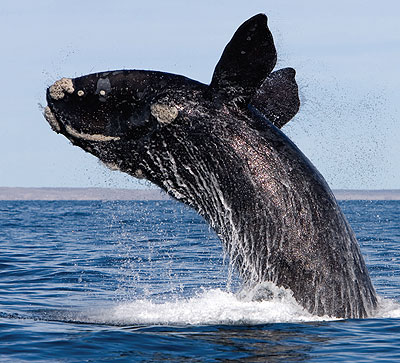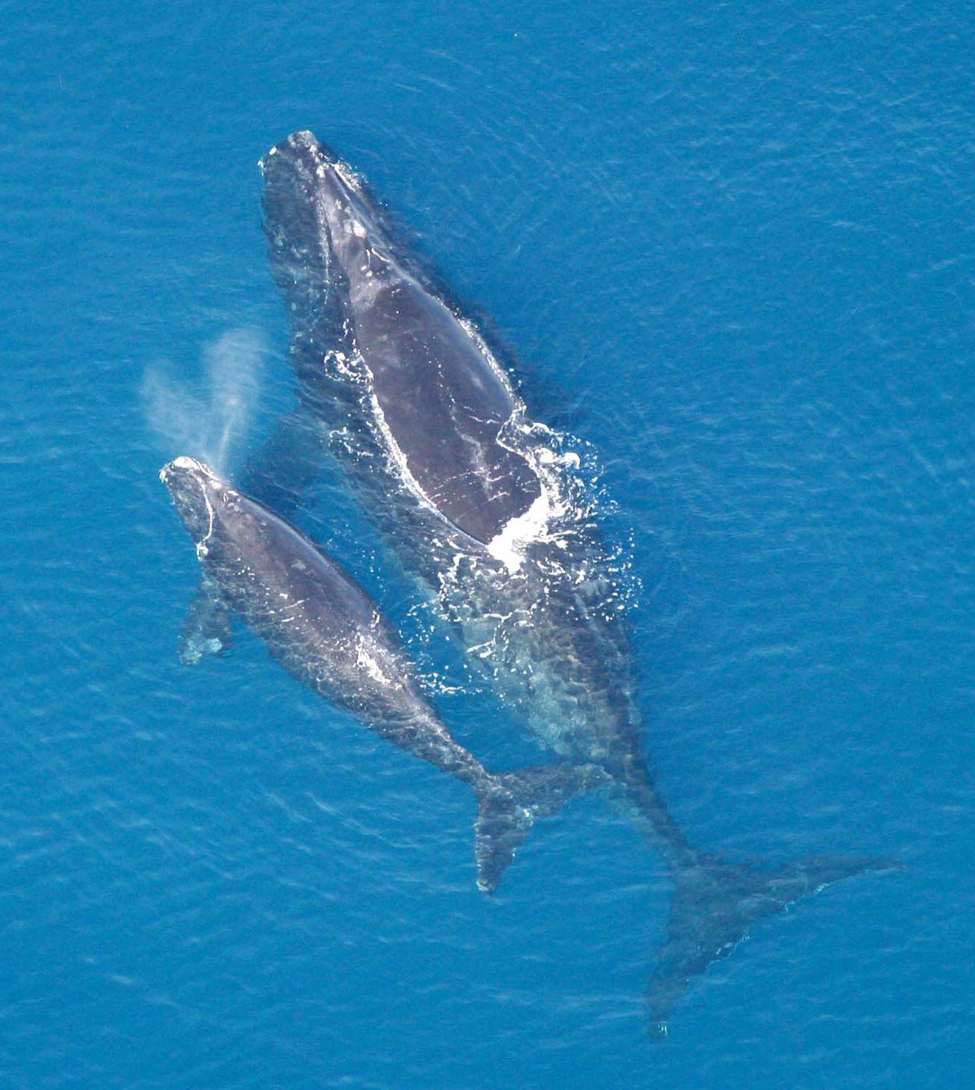Large whales are part of the heritage of New England. Their populations were greatly diminished by commercial whaling in the past. Efforts are underway to restore these populations and  conserve their habitat, so that they can flourish, and we can continue to enjoy their seasonal presence in our waters.
conserve their habitat, so that they can flourish, and we can continue to enjoy their seasonal presence in our waters.
Humpback Whale
North Atlantic humpback whales are currently listed as endangered under the U.S. Endangered Species Act (ESA). National Oceanic and Atmospheric Administration (NOAA) Fisheries has proposed delisting the humpback whale from the Endangered Species Act. Sierra Club and other groups submitted comments that we feel this decision is premature.
Right Whale
The North Atlantic right whale is one of the most endangered whale species in the world. Formerly numbering in the thousands, there are currently fewer than 500 individuals living in their remaining habitat on the U.S. east coast and Canada. Right whales were one of the most popular targets for whalers as early as the eleventh century; in fact, the moniker “right whale” comes from the fact that they were the right whales to hunt. Their slow speed, docile nature, coastal habitat, and tendency to feed at the surface made them both easy to find and easy to kill. Additionally, forty percent of a right whale’s body mass is low-density blubber, much higher than most other whale species. This means that dead right whales float on the surface, allowing whalers to collect the blubber without needing to haul the entire carcass onboard their ships.
As a result, North Atlantic right whales were heavily overhunted for many centuries. By the mid 1700s, the population in the North Atlantic was reduced to the point that whalers began focusing on other species. By 1935, the entire world population was estimated to be below 100 individuals. Finally, governments decided it was time to take action, and a global ban on hunting North Atlantic right whales went into effect in 1935.
Although the ban has allowed the population to recover slightly, the whale is still in grave danger of extinction from humans. A significant portion of North Atlantic right whale deaths are due to human activities; from 1970 to 2006, almost half of all deaths were anthropogenic. The two leading causes of death are ship strikes and fishing gear entanglement, as the habitat of the species overlaps with busy shipping lanes and high use fishing areas. Ship strikes were responsible for over a third of North Atlantic right whale deaths until a speed limit for ships was enacted in 2007. Since that time, entanglement has surpassed ship strikes as the greatest threat to the species. Over eighty percent of individuals have experienced at least one entanglement event. Even if a whale manages to free itself, it may suffer injuries which weaken it or lower its fertility. Anthropogenic climate change is another threat, as even a slight change in climate patterns can have drastic effects on populations of the whales’ main food source, zooplankton.
Because the North Atlantic right whale has such a small population and a low annual reproductive rate, a single whale death can have a significant negative impact on the species’ ability to recover. However, this also works in the other direction: preventing a single whale death can increase the chance of recovery. The Sierra Club’s work has been focused towards eliminating as many whale fatalities as possible.
Since the early 2000s, a number of important milestones have been reached towards reducing the number and lethality of ship strikes. For example, there have been numerous changes to the shipping routes along the East Coast to avoid areas with a high whale density. In 2006, the National Oceanic and Atmospheric Administration (NOAA) created a series of recommended vessel routes which would attempt to avoid areas where right whales frequented, including near Cape Cod. In 2007 and 2009, the NOAA changed the location and size of the shipping lines around Boston to reduce the chance of ship strikes. And in 2008, the NOAA enacted a speed limit of 10 knots (~11.5 mph) for ships larger than 65 feet in areas with many whales during certain times of year.

As for reducing entanglement events, the long term benefits of measures in the U.S. remain in question, as studies have found that the incremental modifications of fishing gear have not significantly reduced entanglement or serious injury rates. Attempts to reduce risk in the U.S. include the adoption of sinking groundline. Floating groundline used by lobstermen to connect their traps could arc in the water column up to nearly 20 feet, depending on the tide. The fact that the line floats in the water column greatly increases the likelihood of a whale swimming into it than if the line sank to the ocean floor. The Sierra Club was instrumental in getting floating groundline banned year-round in Cape Cod Bay in 2004, and in getting it banned in all Massachusetts waters in 2007. However, sinking line has drawbacks for lobstermen: it breaks more easily due to abrasion with the seafloor and is more expensive. For the first issue, scientists and engineers from the Massachusetts Division of Marine Fisheries (MADMF) worked to discover the exact causes of rope failure and develop a sturdier non-buoyant line. For the second issue, the Sierra Club collaborated with the MADMF and Senator John Kerry to institute a buy-back program for floating lines. Under the program, lobstermen could swap their old groundlines for new, sinking lines at a reduced cost. The program was highly successful, and over 300,000 pounds of rope were exchanged.
With all the improvements made towards protecting North Atlantic right whales, a brief glimmer of hope appeared for the species between 1990 and 2010, during which a modest increase in growth rate was detected. However, since that time the population appears to once again be in a state of decline, with the threats of entanglement and ship strikes continuing to prevent the recovery of the species. An unprecedented number of deaths in 2017 in Atlantic Canada is cause for serious concern. Now is not the time to get complacent, as it is critical that right whales continue to be protected. The efforts of the Sierra Club and other environmental groups must not be wasted, and we must continue to work to change the world.
For more, read Can Atlantic Whale Deaths Be Stopped? in Sierra, the national magazine of the Sierra Club.